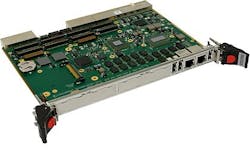VXS/VME, CompactPCI, and AdvancedMC boards based on Intel 3rd Generation Core processors introduced by Concurrent
WOBURN, Mass., 25 April 2012. Concurrent Technologies Inc. this week is introducing three embedded computing products based on the newly announced Intel 3rd Generation Core microprocessor -- the VX 91x/01x 6U VXS/VME single-board computer, the PP 93x/x1x single slot air-cooled 6U CompactPCI single-board computer, and the AM 92x/x1x Advanced Mezzanine Card (AdvancedMC).
These announcements are part of an industrywide flurry of product announcements since Monday when Intel Corp. in Santa Clara, Calif., announced its 3rd Generation Core microprocessor family, formerly known as Ivy Bridge, which is based on 22-nanometer fabrication technology and promises faster performance than the 2nd Generation Intel Core microprocessors that had been code-named Sandy Bridge.
The Concurrent Technologies VX 91x/01x 6U VXS/VME single-board computer, which complies with the VITA 41.x standard, has enhanced processing and graphics from the quad-core Intel Core i7-3615QE or the quad-core Intel Core i7-3612QE processors. The board is designed to provide a plug-and-play upgrade path for users of earlier generations of Concurrent 6U VXS/VME embedded computing products for military embedded systems for data acquisition, instrumentation, control systems, and signal processing.
The 3rd generation Intel Core processors offer enhanced graphic and processing capabilities resulting in an increase of as much as 15 percent in CPU performance and an increase of as much as 50 percent in graphics performance. The 3rd generation Intel Core processor extends itself to support compute-intensive applications by providing support for OpenCL.
The VX 91x/01x supports as much as 16 gigabytes of ECC DDR3 SDRAM, and offers configurable PCI Express fabric interface supporting 1 x8, two x4, 1 x4 + 1 x4 at Gen 1 or Gen 2 data rates, dual Gigabit Ethernet, dual SATA600, dual PMC / XMC slots, dual serial RS232/422/485 ports, six USB 2.0 ports, dual independent display ports, on-board CompactFlash, and optional 2.5 inch hard drive.
The VX 91x/01x is available in three temperature grades: 0 to 55 degrees Celsius (N-Series); -25 C to 70 C (E-Series); and -40 C to 85 C (K-Series). The boards also come in two ruggedized grades: ruggedized conduction-cooled -40 C to 85 C (RC) and ruggedized air-cooled -40 C to 75 C (RA).
The Concurrent Technologies PP 93x/x1x is a single-slot air-cooled 6U CompactPCI single-board computer with the 3rd generation Intel Core processors. The board has front and rear I/O interfaces, has as much as 16 gigabytes of ECC SDRAM, and is designed to provide an upgrade path for earlier generations of 6U CompactPCI products.
The board has as two 100 MHz PCI-X PMC or XMC x4/x8 PCI Express sites, 1x RS232, 2x Gigabit Ethernet, 3x USB 2.0 sites, and 4x SATA interfaces. The front panel supports as much as 3x USB 2.0 interfaces, 2x Gigabit Ethernet, optional DVI-I graphics and optional RS232 interface. For application and data storage there is an on-board site for a CompactFlash module and an on-board option for a SATA600 2.5-inch disk drive.
The board can operate as a system controller board, a peripheral board. or as a satellite blade. Support is also provided for PICMG 2.16 (Ethernet fabric), PICMG 2.9 (IPMI) and PICMG 2.1 (hot swap); the CompactPCI backplane interface operates at 33/66 MHz PCI signalling speeds.
The PP 93x/x1x is for military and medical applications and scales from commercial temperature grade 0 C to 55 C (N-Series) through to extended temperature grade -40 C to 85 C (K-Series).
For more information contact Concurrent Technologies online at www.gocct.com.
Follow Military & Aerospace Electronics and Avionics Intelligence news updates on Twitter

John Keller | Editor
John Keller is editor-in-chief of Military & Aerospace Electronics magazine, which provides extensive coverage and analysis of enabling electronic and optoelectronic technologies in military, space, and commercial aviation applications. A member of the Military & Aerospace Electronics staff since the magazine's founding in 1989, Mr. Keller took over as chief editor in 1995.



